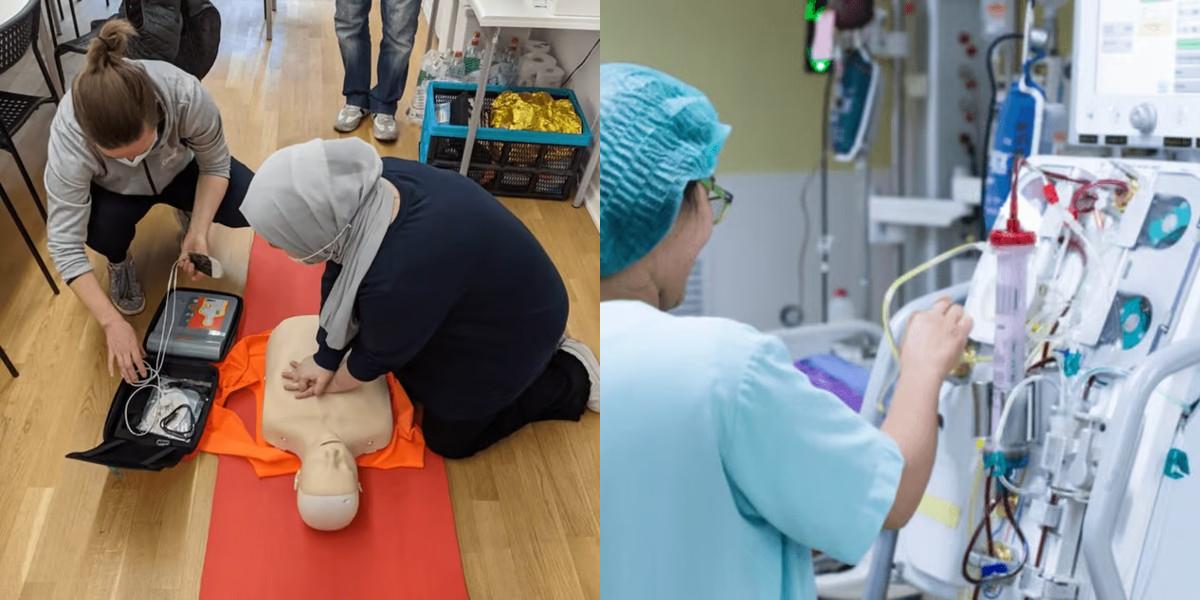CPR-BLS vs Hemodialysis Technician

Want personalized recommendations?
Let's match you to the right program

Key Points:
- CPR-BLS providers perform emergency life-saving techniques, while Hemodialysis Technicians operate dialysis machines and monitor patients' treatment.
- CPR-BLS providers typically earn less than Hemodialysis Technicians.
- CPR-BLS training is generally less expensive and shorter than the extensive training required for Hemodialysis Technicians.
In the healthcare industry, there is a wide range of career opportunities available, each with its own unique set of responsibilities and requirements. CPR-BLS and Hemodialysis Technician are two such options that individuals often consider. While they both involve working in a healthcare setting, the specific roles and responsibilities of each differ significantly.
Article continues after recommendations
Recommended for you
What is CPR-BLS and Hemodialysis Technician?
CPR-BLS: CPR-BLS stands for Cardiopulmonary Resuscitation - Basic Life Support. It is a certification program that trains individuals in life-saving techniques such as CPR, AED usage, and first aid. CPR-BLS certification is often required for healthcare professionals, including nurses, doctors, and emergency medical technicians, as well as individuals who work in childcare, fitness, and other industries.
Hemodialysis Technician: A Hemodialysis Technician is a healthcare professional who operates and maintains equipment used in the treatment of patients with kidney failure. They are responsible for setting up the dialysis machine, monitoring patients during treatment, and ensuring the safety and comfort of the patients. Hemodialysis Technicians work under the supervision of nurses and physicians in dialysis centers, hospitals, and other healthcare facilities.
CPR/BLS and Hemodialysis Technician
CPR/BLS certification, usually completed in a few hours to a day, equips individuals with the skills to perform cardiopulmonary resuscitation (CPR) and basic life support (BLS) in emergency situations. Hemodialysis Technicians, requiring several months of specialized training and certification, operate dialysis machines and monitor patients undergoing dialysis treatment for kidney failure.
Difference between CPR-BLS and Hemodialysis Technician
While both CPR-BLS and Hemodialysis Technicians involve working in a healthcare setting, there are several key differences between the two:
-
Scope of Practice: CPR-BLS is a certification that equips individuals with the skills to respond to emergencies, administer CPR, and provide basic life support. Hemodialysis Technicians, on the other hand, have a more specialized role in the treatment of patients with kidney failure.
-
Responsibilities: CPR-BLS certified individuals are responsible for providing immediate care in emergency situations, such as cardiac arrests, choking incidents, and other life-threatening scenarios. Hemodialysis Technicians, on the other hand, are responsible for operating dialysis machines, monitoring patients during treatment, and ensuring the proper functioning of the equipment.
-
Work Environment: CPR-BLS certified individuals can work in a variety of settings, including hospitals, clinics, schools, and fitness centers. Hemodialysis Technicians primarily work in dialysis centers, hospitals, and other healthcare facilities that offer kidney dialysis services.
-
Job Outlook: The demand for CPR-BLS certified individuals is consistent, as emergencies can occur at any time. Hemodialysis Technicians, on the other hand, are in high demand due to the increasing prevalence of kidney disease and the need for dialysis treatment.
CPR-BLS vs Hemodialysis Technician: Job Description
CPR-BLS Job Description:
- Administer CPR and basic life support techniques in emergency situations
- Perform first aid procedures to stabilize patients before medical help arrives
- Use AEDs (Automated External Defibrillators) to restore normal heart rhythms
- Provide emotional support to patients and their families during emergencies
Hemodialysis Technician Job Description:
- Set up and operate dialysis machines
- Monitor patients during dialysis treatment, ensuring their safety and comfort
- Administer local anesthetics and medications as directed by healthcare professionals
- Document and maintain accurate records of patient treatments and progress
Get courses selected just for you
Try our powerful search engine
CPR-BLS vs Hemodialysis Technician: Education and Training
CPR-BLS Education and Training:
- CPR-BLS certification programs are typically short in duration and can be completed in a matter of hours or days.
- These programs are widely available in various healthcare training centers, community colleges, and online platforms.
- The training includes both theoretical knowledge and practical hands-on skills.
Hemodialysis Technician Education and Training:
- Hemodialysis Technician training programs are more comprehensive and typically last for several months or up to a year.
- These programs are offered by vocational schools, community colleges, and healthcare training centers.
- The curriculum includes classroom instruction, laboratory practice, and supervised clinical experience.
CPR-BLS vs Hemodialysis Technician: Career Outlook and Salary
CPR-BLS Career Outlook and Salary:
- CPR-BLS certification enhances the employability of healthcare professionals in various fields.
- The demand for CPR-BLS certified individuals is consistent, as emergencies can occur at any time.
- According to the Bureau of Labor Statistics, the median annual wage for EMTs and paramedics, who often hold CPR-BLS certification, was $35,400 in May 2020.
Hemodialysis Technician Career Outlook and Salary:
- The demand for Hemodialysis Technicians is expected to grow significantly due to the increasing prevalence of kidney disease.
- According to the Bureau of Labor Statistics, the median annual wage for Medical Equipment Preparers, which includes Hemodialysis Technicians, was $38,280 in May 2020.
Final Thoughts
Choosing the right vocational training program is crucial for individuals seeking to enter the healthcare field. CPR-BLS certification equips individuals with life-saving skills and enhances their employability in various healthcare roles. On the other hand, becoming a Hemodialysis Technician provides individuals with a specialized skill set that is in high demand due to the increasing prevalence of kidney disease. Ultimately, the choice between CPR-BLS and Hemodialysis Technician depends on an individual's interests, career goals, and passion for either emergency response or specialized patient care.
Dreambound's educational programs are available in diverse locations. Explore these recommended blogs for a comprehensive examination of the two vocations, including in-depth insights into their prerequisites and guidance on initiating your journey:

Blessed Joy Amarga is part of the Growth and Sales teams at Dreambound. She helps bring in new leads, increasing the number of people at the top of the sales funnel, and supporting the team in creating graphics to boost social media engagement. Blessed is also a Licensed Architect. Outside work, she enjoys traveling and exploring new places for her vlog.


